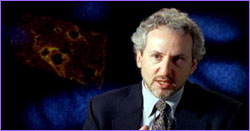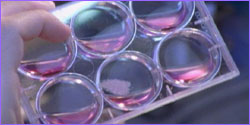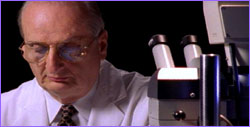
|

|
Dr. Folkman Speaks
Part 2 |
Back to Part 1
NOVA: It took just as long to find angiogenesis
inhibitors, those that inhibit blood-vessel growth,
right?
Dr. Folkman: Yes. In 1980 came interferon, in 1981 or
1982 came platelet factor 4. These were the first two. By
then we said there are angiogenesis inhibitors.
NOVA: And a member of your team found the third one
by accident?
|
 Don Ingber had the presence of mind to study a
curious contaminant rather than simply dispose of
it.
Don Ingber had the presence of mind to study a
curious contaminant rather than simply dispose of
it.
|
Dr. Folkman: Yes. Don Ingber was an M.D., Ph.D. who
had come up from Yale and was studying endothelial cells.
Every time a new building was being built outside Children's
Hospital, funguses would come into the windows, and you'd
get contamination of these in the cell cultures. When you
got a fungus growing in there, it would turn turbid, and the
little dish of cells would all die and float.
So Don had a set of endothelial cells, and there was a
fungus contaminant at one end of the dish. He called me and
said you have to come in and see this, because there's
something different. The cells were not dying, they
were just backing away. He said there's something diffusing,
something coming from the fungus that is stopping the
endothelial cells.
Now, what's important is that anyone else in the lab would
have thrown that out. There were signs all over the lab that
said if your cell culture becomes contaminated with a
fungus, you must throw it out, because if you try to keep it
and treat it, it will infect the whole lab. I used to get
upset with people who didn't, so Ingber called and said I
would like permission to keep this culture.
 A fungus that contaminated Ingber's cultures lead
to the angiogenesis inhibitor known as TNP470.
A fungus that contaminated Ingber's cultures lead
to the angiogenesis inhibitor known as TNP470.
|
|
That led to the isolation of a compound that is today in
clinical trial. The whole purification was done by Takeda
Chemical Industries, because they are very good at growing
funguses. They made the chemical which is today called
TNP-470, Takeda neoplastic product #470. It's in clinical
trial, and in animal tumors it has a very broad spectrum
antitumor effect. It was a little stronger than platelet
factor 4 and much stronger than interferon. So that was a
purely serendipitous discovery. [For other unplanned-for
finds in medicine, see
Accidental Discoveries.]
NOVA: Two angiogensis inhibitors your team
discovered—endostatin and angiostatin—are now in
clinical trials [see
Designing Clinical Trials]. How do you feel about the patients who are trying your
new therapy?
Dr. Folkman: Patients going through these trials are
in a desperate situation. Nothing else has worked, there's
little time left—and they have a fast clock running.
We all have a clock but theirs is very fast. And so they're
very scared. Therefore, from a physician's point of view,
you have to go out of your way to make sure that not only
they understand but that you don't destroy their hope.
NOVA: A friend of mine keeps asking me, since these
people in clinical trials are terminally ill, why don't you
give them a lot of, say, endostatin?
Dr. Folkman: What if a lot turns out to be dangerous?
Then you've made their life worse than it was. The ethic is
"above all do no harm." To build on that rule, an old rule
in medicine, the Food and Drug Administration through
federal laws have said when you start a new drug, you must
start much lower than you expect it to be effective. That is
the safe thing to do. But it creates an ethical problem that
that might be an ineffective dose.
NOVA: And even with larger doses, you don't want to
raise anyone's hopes too high.
|
 Watch clip of Judah Folkman on "raising
expectations."
Watch clip of Judah Folkman on "raising
expectations."
QuickTime
RealVideo:
56K
|
ISDN+
|
Dr. Folkman: Yes. Many times when you see the very
first experiments in mice and then you try it in people,
there's always a great deal of hope among patients and
physicians that it will be an improvement. It's the same
problem we have with endostatin and angiostatin. But there's
also a high risk of let-downs or raising expectations too
high. Because when you go from the laboratory to people,
there's a high failure rate. All mice are identical twins;
all people are not.
Our view is that in time angiogenesis inhibitors will be
added to chemotherapy, added to radiotherapy, added to
immunotherapy, added to gene therapy, and added to one
another. And eventually, one by one, doctors will have a
whole arsenal of these, and that may improve things. We
hope. But the excitement of the discovery of them comes
across sometimes too much when you're trying to explain
it.
 Among Dr. Folkman's hopes for anti-angiogenesis
drugs: There will eventually be many varieties of
them, and they will help usher in an era of
decreased toxicity and drug resistance.
Among Dr. Folkman's hopes for anti-angiogenesis
drugs: There will eventually be many varieties of
them, and they will help usher in an era of
decreased toxicity and drug resistance.
|
|
NOVA: What are your biggest hopes?
Dr. Folkman: The best hopes for the field or these
drugs is they're going to be many. If endostatin or
angiostatin should fail, the principles are solid, they've
been established over 30 years. They've been replicated over
30 years by laboratories around the world, and other
laboratories are making more and more discoveries based on
the principles. Demonstrating proof of principle in the
clinic that you can control tumors or slow them down or
regress them by anti-angiogenic therapy is the
hope—that's what we're working on. Eventually we hope
that that will come, even if it means that you have to give
two angiogenesis inhibitors together, because that's what we
have to do in mice to get a really good tumor eradication.
So physicians in the next decade may have an arsenal of
angiogenesis inhibitors, possibly 10 or 20, and they can
combine them and choose among them and add them to other
therapies to increase the power of the control that doctors
have over cancer.
The other hope is that the toxicity will come down, that
there will be less and less over the years of the punishing
toxicity that patients have to put up with now. (That
happened in infection. In the 1930s we had arsenic, which is
really toxic. Then we had sulfur in the late `30s—less
toxicity. Then we had penicillin in the `40s, really low
toxicity.) A third hope is that drug resistance will
gradually disappear, because now that's the biggest problem
in cancer therapy.
Dr. Folkman Speaks
|
Cancer Caught on Video
Designing Clinical Trials
|
Accidental Discoveries
| How Cancer Grows
Help/Resources
|
Transcript
|
Site Map
|
Cancer Warrior Home
Editor's Picks
|
Previous Sites
|
Join Us/E-mail
|
TV/Web Schedule
About NOVA |
Teachers |
Site Map
|
Shop |
Jobs |
Search |
To print
PBS Online |
NOVA Online |
WGBH
©
| Updated February 2001
|
|
|